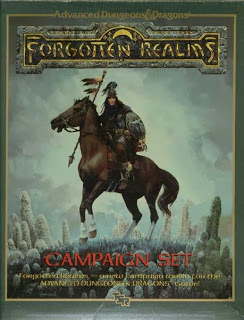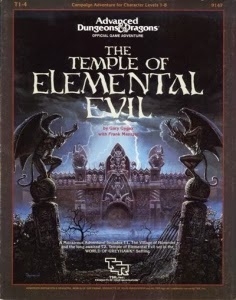One of the great differences between the “silver age” of AD&D 1st edition, and more modern editions, is the preference for showing in the earlier products, vs. telling in the newer ones. “Showing” means that details are given in the context of an adventure, and only those details that matter to the particular adventure are given. “Telling” means that details are given in a big honking info-dump, with all sorts of information that will be completely irrelevant to the DM. Indeed, it forces the DM to play the scholar if he wants to use the setting as written. Something casual Forgotten Realms fans have lamented for years.
A lot of it has to do with market forces. A rule supplement is going to sell more than an adventure module, and something aimed at “all players” is going to sell more than something aimed strictly at dungeon masters. Completely understandable, but before 1985 or so, when the designers wanted to introduce a new big bad, or flesh out some locale, they did so in the context of an adventure. After 1985 (when Gygax was forced out of TSR), that changed, and adventures were aimed more to push sales of setting books or, later, rulebooks.
Take, for example, the quintessential introduction of a new major demon queen, Zuggtmoy, in the module T1-4, Temple of Elemental Evil. The only history that was presented was that which was essential to the adventure, and she’s presented at the end of the module in an appendix like any other new monster (ditto for Saint Cuthbert). Players (and for that matter, dungeon masters) were expected to learn about her by interacting with the campaign setting, and piecing together bits and pieces scattered hither and yon.
Contrast that with later products, such as Manual of the Planes, which was basically an information dump that forced a level of uniformity on the inner, outer, astral, and ethereal planes that would not have been the case if, for instance, the planned adventures Shadowland and the vaguely outlined series of outer planes adventures had been published (or, for that matter, Rob Kuntz’s City of Brass or Demonland adventures; City of Brass was eventually published, but without the official imprimatur that would have made necessitating a section of Manual of the Planes irrelevant).
Dragonlance, for all its flaws, did this very well at the beginning, and I always liked that about the series and the setting. The players and the DM learned about Krynn through the adventures, which contained the information needed for the adventure and maybe some extended background to cover contingencies. But no big sourcebooks. Those came later.
I don’t count the original World of Greyhawk folio or boxed set because they were very deliberately written at a 10,000 foot level. There were tantalizing hints scattered around, but there was never a comprehensive and exhaustive treatment of some personage, kingdom, or subject. It was all a skeletal framework upon which the DM could fill in the details.
As the editions wore on, the trend to fill in all the blanks only got worse. To take but one example, in doing research for my new Darker Paths book (Demonolater), I needed some information on the home planes of various demon lords. The information is scattered across at least a half-dozen rulebooks published in the last ten years, each with an ever-growing accumulation of information that just gets recorded, and published, and added to.
Never actually used. Never actually relevant in a published adventure. Just… there. Like an encyclopedia. Planescape sort of tried to show, rather than tell, but in so doing it was forced to reduce the outer planes to “just another campaign setting” and that drained all the specialness out of them. And in the end they ended up with sourcebooks that told, rather than showed. (There were 12 adventures, 6 boxed sets, and 14 accessories; clearly the telling was weighted more than the showing.)
I vastly prefer showing rather than telling. You want to do an info-dump about the home plane of Graz’zt? Do it in the context of an adventure where the PCs are wandering around. That would be not only a lot more fun, but it would also introduce all the interesting little special bit and bobs that arise when you’re considering the low-level impact of what you’re writing. Better by far, in my opinion, than a “Graz’zt sourcebook” or something.
That’s how I am proceeding, anyway.












Excellent article! D'accord.
Great point about only in the context of actually writing a usable adventure do the interesting details (and real creativity) emerge.
Human being are naturally classifiers. We can't help it. But it makes for a pretty bland text.
"Now let me see…we have 9 gods of this type, and 12 gods of this type…blah blah blah."